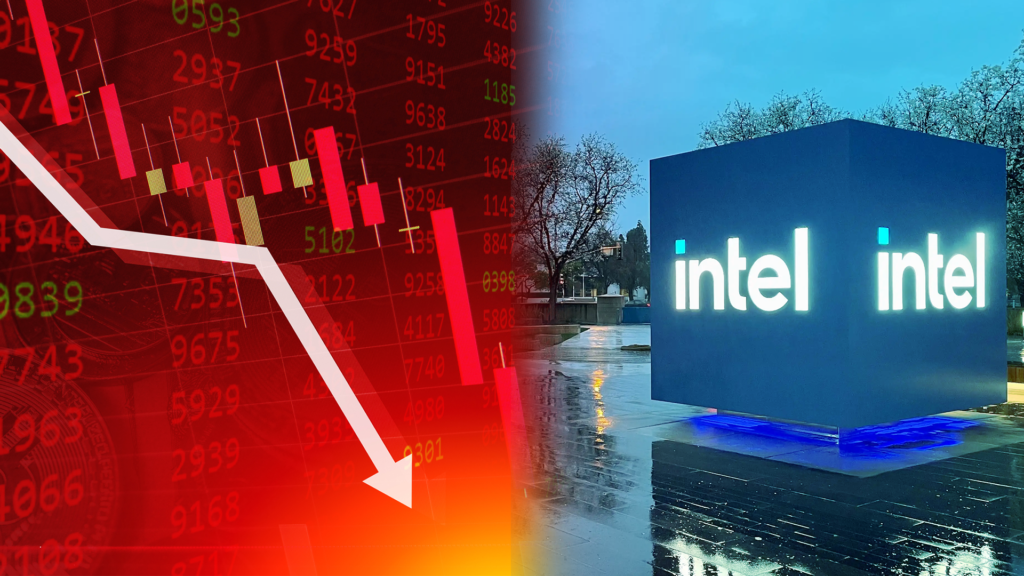Intel’s recent financial performance has raised alarms across the tech industry. The company’s Q2 earnings report revealed significant shortfalls, leading to drastic measures to realign its operations. With a focus on “Intel Q2 earnings miss”, this blog post delves into the implications of Intel’s latest financial results, the company’s strategic response, and the broader impact on the semiconductor industry.
A Disappointing Q2: What Went Wrong?
Intel’s Q2 earnings fell short of Wall Street’s expectations by a substantial margin. The chipmaker reported an adjusted earnings per share (EPS) of just $0.02 on revenues of $12.83 billion. These figures were well below analysts’ predictions of $0.10 EPS and $12.92 billion in revenue. Compared to the same quarter last year, Intel’s earnings plummeted 85%, while sales dropped 1%. This sharp decline has intensified concerns about the company’s financial health and future prospects.
The market reaction was swift and severe. Intel’s stock plunged over 19% in extended trading, marking one of the worst drops since 2000. This sell-off underscores the gravity of Intel’s Q2 earnings miss and the waning investor confidence in the company’s ability to navigate the challenging landscape of the semiconductor industry.
Strategic Response: Cost-Cutting and Restructuring
In response to its Q2 earnings miss, Intel announced a comprehensive cost-reduction plan aimed at realigning its financial structure with the current market realities. The company has initiated a $10 billion cost-cutting program, which includes a 15% reduction in its workforce. This move is part of Intel’s broader strategy to streamline operations, improve efficiency, and refocus on its core competencies.
Intel also made the tough decision to suspend its quarterly dividend starting in the fourth quarter. This suspension is seen as a necessary step to preserve cash flow and support the company’s long-term strategic investments, particularly in the AI and foundry businesses.
Intel’s Q3 Outlook: More Challenges Ahead
Looking ahead to Q3, Intel’s forecast remains bleak. The company expects an adjusted loss of $0.03 per share on revenues ranging between $12.5 billion and $13.5 billion. These projections are again below Wall Street’s expectations, which had anticipated earnings of $0.31 per share on $14.43 billion in revenue. This downbeat guidance reflects ongoing pressures in the market, including weaker consumer and enterprise spending and elevated customer inventory levels.
Intel’s CFO, David Zinsner, highlighted the impact of these factors, noting that “weaker spending across consumer and enterprise markets, especially in China, and continued focus on AI server investments in the cloud have reduced our total addressable market expectations for 2024.” The company is also facing intensified competition from rivals like AMD and Nvidia, particularly in the high-growth AI and data center markets.
The Broader Impact on Intel’s Business Segments
Intel’s Q2 report also shed light on the performance of its key business segments. The Data Center and AI segment generated $3.05 billion in revenue, slightly below expectations of $3.07 billion. While this segment remains critical to Intel’s growth strategy, the company is struggling to keep pace with Nvidia, whose GPUs are considered the industry standard for AI processing.
The Client Computing segment, which includes sales of chips for enterprise and consumer computers, remains Intel’s largest business. However, this segment also underperformed, with revenue of $7.4 billion falling short of Wall Street’s $7.5 billion forecast. The PC market’s slow recovery after consecutive quarters of decline has added to Intel’s challenges, exacerbated by competition from Qualcomm and Apple’s M-series chips.
Intel’s Path Forward: Can It Regain Its Footing?
Intel’s Q2 earnings miss has undoubtedly set the stage for a challenging second half of the year. The company’s aggressive cost-cutting measures and strategic shifts underscore the urgency of its turnaround efforts. However, the road ahead is fraught with obstacles, from intensifying competition to shifting market dynamics.
Intel’s ability to execute its turnaround strategy and regain its leadership position in the semiconductor industry will be closely watched by investors and industry analysts alike. As the company navigates these turbulent times, the focus will remain on how well it can adapt to the evolving landscape and capitalize on emerging opportunities in AI, data centers, and beyond.
In conclusion, Intel’s Q2 performance serves as a stark reminder of the volatility and competition inherent in the semiconductor industry. The company’s Q2 earnings miss has prompted a significant restructuring effort, but the effectiveness of these measures will determine Intel’s future trajectory. As the industry continues to evolve, Intel’s strategic decisions in the coming months will be critical in shaping its long-term success.
